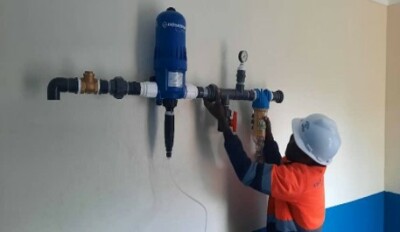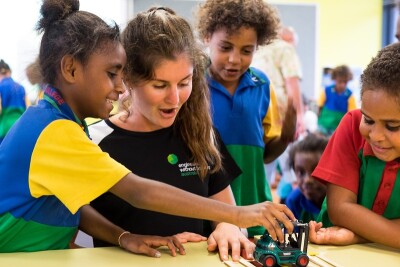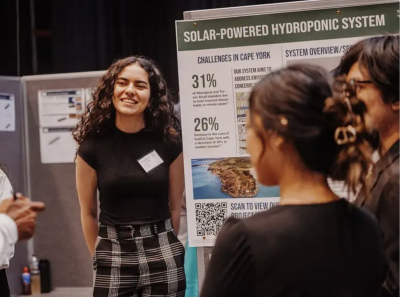Engineers Without Borders International, a global group whose mission is to bring together the global Engineers Without Borders network, recently announced a strategic partnership with Bentley Systems. The partnership is the organization’s first of its kind, and it will provide funding, expertise, and networking for the group.
While individual national Engineers Without Borders organizations have existed in various countries around the world since the 1980’s, Engineers Without Borders International was developed more recently to enhance collaboration between the individual organizations and strengthen their work around the globe. Executive Director Katie Cresswell-Maynard recently spoke with Geo Week News to talk about the organization’s new partnership with Bentley, as well as to provide information about EWB’s history and the work the global movement is doing.
A Brief History of Engineers Without Borders
As mentioned above, Engineers Without Borders International was created after many of the individual organizations, with the first organization being established in France in the 1980s as a response to the famine being experienced at the time in Ethiopia. Since then, Cresswell-Maynard estimates that there have been about 60 EWB organizations around the world.

These individual groups vary greatly in both size and structure. Some include just a handful of individuals, while others have up to 50. Further, some include full-time staff, while others are entirely volunteer-run. That being said, Cresswell-Maynard stresses that “every organization is reliant on volunteer power,” leaning on engineering experts to provide their skills and expertise towards crucial projects.
About 20 years ago, Engineers Without Borders International was formed as a way to bring these individual organizations together into a broader global movement. The individual organizations still act as their own entity, but the hope is to bring their work together more and be able to leverage the global expertise at an even higher level than has already been accomplished. Cresswell-Maynard describes the mission as focusing on, “How do we create a future where all people on the planet can thrive?” She also references the UN’s 2030 Agenda for Sustainable Development, which includes goals for ending poverty in all forms, noting that part of Engineers Without Borders International’s mission is figuring out, “How do we divert the skills and expertise of engineering towards achieving that vision?”
Working towards a better future
In talking about the work being done by the Engineering Without Borders organizations, Cresswell-Maynard points to two “core aims” in which projects generally fall. One is what most people would likely think of when imagining a group like this, working to deliver critical infrastructure to communities in need and in crisis. Much of this has revolved around creating infrastructure to more easily provide clean water to communities in need.
Cresswell-Maynard also shared an example in Vanuatu, a Pacific island nation which is among the most at-risk countries in the world in terms of climate-related impacts. There, Engineers Without Borders Australia has worked with the Vanuatu government to help develop, “not just policies, but the mechanisms by which they can be better prepared for, and then respond in a crisis to ensure people still have access to clean water and good sanitation.”

Along with this work around delivering crucial infrastructure, Cresswell-Maynard tells Geo Week News that focus is also placed on nurturing the next generation of engineers. Referring back to those UN goals for 2030, she notes the “role of engineers is so important, and yet there’s one, a capacity gap, and two, a great need for increased diversity in the sector.”
To that end, she also explains some other projects that fall more under that category of education and development than what one might typically think of when they hear about Engineers Without Borders. For example, she notes that some organizations hold what they call design challenges for university students, “inspiring them to think outside the box, experience a different context than the ones they’re used to, and develop not just problem solving skills, but the problem identification skills as well.” To date, nearly 200,000 students from around the globe have taken part in these design challenges.
While those are just a few examples of some of the work being done on the ground by individual organizations, with support from Engineers Without Borders International, Cresswell-Maynard also tells us about some new work being done by the latter organization to further this collaboration. Just this month, representatives from eight national Engineers Without Borders organizations – Australia, Canada, Nigeria, Philippines, Singapore, Somalia, Sweden, and the United States – launched the development phase of a global innovation program.
Engineers Without Borders International is facilitating this collaboration, with the aim of “designing a program to drive innovation, primarily focused on delivering traction within the significant issue of malnutrition,” per the organization’s announcement of the news. The ultimate goal is to organize and facilitate more of these working groups as Engineers Without Borders International looks to foster greater and more widespread collaboration between the national groups.
EWB-I’s partnership with Bentley
This further development will certainly get a boost from the aforementioned first-of-its-kind for the organization partnership with Bentley. Additional funding from the partnership, as Cresswell-Maynard puts it, “is extremely meaningful and enables us to do things we wouldn’t otherwise be able to do,” but it’s not just the funding that brings value from this.

Much of the value comes back to that idea of Engineers Without Borders International looking to further bring together the national organizations. Cresswell-Maynard told Geo Week News that one of the biggest value-adds from the relationship is “built around leveraging their internal expertise.” Specifically, one of those is their “leadership expertise in bringing together organizations through their integrations team.” It’s something Bentley has excelled at as a company, and that experience should shine through in this context as well. They also could potentially expose more of their clients to the work being done by the global Engineers Without Borders movement who may not have been aware but would be interested in assisting projects around the world.
In a press statement, Dan Koval, Corporate Initiatives Manager at Bentley, said of the partnership, “I’m so excited by the united vision of the Engineers Without Borders movement. I really believe that this is a pivotal moment to be supporting that coordination to happen and I’m proud that Bentley Systems is the first partner to make that investment. I’m looking forward to working with the team and advancing infrastructure together.”






